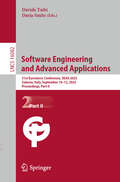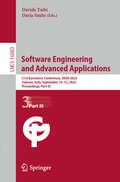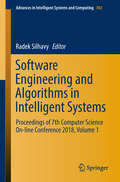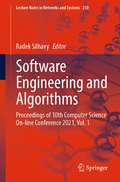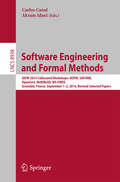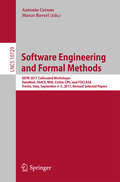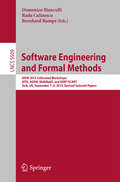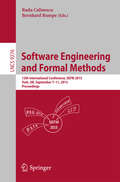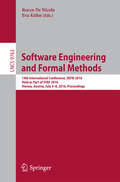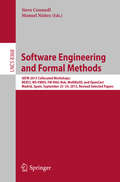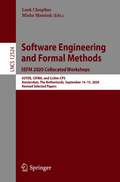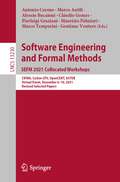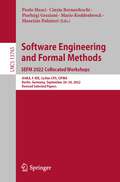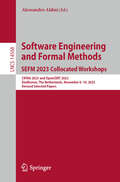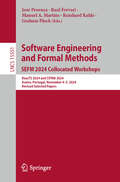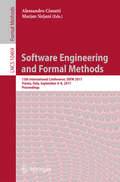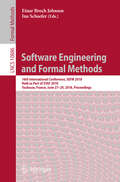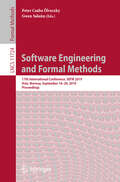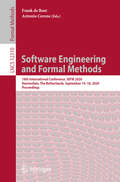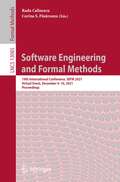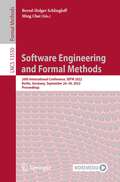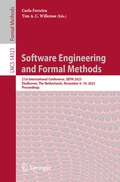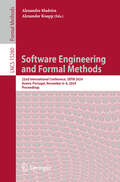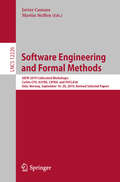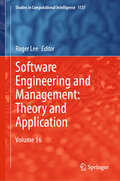- Table View
- List View
Software Engineering and Advanced Applications: 51st Euromicro Conference, SEAA 2025, Salerno, Italy, September 10–12, 2025, Proceedings, Part II (Lecture Notes in Computer Science #16082)
by Davide Taibi Darja SmiteThis three-volume set constitutes the refereed proceedings of the 51st Euromicro Conference on Software Engineering and Advanced Applications, SEAA 2025, held in Salerno, Italy, during September 10-12, 2025. The 62 full papers were carefully reviewed and selected from 177 submissions.These papers were organized in the following topical sections: Part I: Data and AI Driven Engineering; Cyber-Physical Systems; Model-Driven Engineering and Modeling Languages.Part II: Practical Aspects of Software Engineering; Systematic Literature Reviews and Mapping Studies in Software Engineering.Part III: Software Management: Measurement, Peopleware, and Innovation; Software Process and Product Improvement; Software Analytics: Mining Software Open Datasets and Repositories; Emerging Computing Technologies.
Software Engineering and Advanced Applications: 51st Euromicro Conference, SEAA 2025, Salerno, Italy, September 10–12, 2025, Proceedings, Part III (Lecture Notes in Computer Science #16083)
by Davide Taibi Darja SmiteThis three-volume set constitutes the refereed proceedings of the 51st Euromicro Conference on Software Engineering and Advanced Applications, SEAA 2025, held in Salerno, Italy, during September 10-12, 2025. The 62 full papers were carefully reviewed and selected from 177 submissions.These papers were organized in the following topical sections: Part I: Data and AI Driven Engineering; Cyber-Physical Systems; Model-Driven Engineering and Modeling Languages.Part II: Practical Aspects of Software Engineering; Systematic Literature Reviews and Mapping Studies in Software Engineering.Part III: Software Management: Measurement, Peopleware, and Innovation; Software Process and Product Improvement; Software Analytics: Mining Software Open Datasets and Repositories; Emerging Computing Technologies.
Software Engineering and Algorithms in Intelligent Systems: Proceedings Of 7th Computer Science On-line Conference 2018, Volume 1 (Advances In Intelligent Systems And Computing #763)
by Radek SilhavyThis book presents new software engineering approaches and methods, discussing real-world problems and exploratory research that describes novel approaches, modern design techniques, hybrid algorithms and empirical methods. This book constitutes part of the refereed proceedings of the Software Engineering and Algorithms in Intelligent Systems Section of the 7th Computer Science On-line Conference 2018 (CSOC 2018), held in April 2018.
Software Engineering and Algorithms: Proceedings of 10th Computer Science On-line Conference 2021, Vol. 1 (Lecture Notes in Networks and Systems #230)
by Radek SilhavyThis book constitutes the refereed proceedings of the Software Engineering and Algorithms section of the 10th Computer Science On-line Conference 2021 (CSOC 2021), held on-line in April 2021. Software engineering research and its applications to intelligent algorithms take an essential role in computer science research. In this book, modern research methods, application of machine and statistical learning in the software engineering research are presented.
Software Engineering and Formal Methods
by Carlos Canal Akram IdaniThis book constitutes revised selected papers from the workshops collocated with the SEFM 2014 conference on Software Engineering and Formal Methods, held in Grenoble, France, in September 2014. The 26 papers included in this volume were carefully reviewed and selected from 49 submissions. They are from the following workshops: the 1st Workshop on Human-Oriented Formal Methods - From Readability to Automation, HOFM 2014, the 3rd International Symposium on Modelling and Knowledge Management Applications - Systems and Domains, MoKMaSD 2014, the 8th International Workshop on Foundations and Techniques for Open Source Software Certification, Open Cert 2014, the 1st Workshop on Safety and Formal Methods, SaFoMe 2014 and the 4th Workshop on Formal Methods in the Development of Software, WS-FMDS 2014.
Software Engineering and Formal Methods
by Antonio Cerone Marco RoveriThis volume contains the papers presented at FMICS 2010, the 15th Inter- tional Workshop on Formal Methods for Industrial Critical Systems, which was held on September 20-21, 2010, in Antwerp, Belgium. Previous workshops of the ERCIM working group on Formal Methods for Industrial Critical Systems wereheld in Oxford(March 1996), Cesena (July 1997), Amsterdam (May 1998), Trento (July 1999), Berlin (April 2000), Paris (July 2001), Malaga (July 2002), Trondheim(June2003), Linz(September 2004), Lisbon(September 2005), Bonn (August 2006), Berlin (July 2007), L Aquila (September 2008), and Eindhoven (November 2009). The aim of the FMICS workshop series is to provide a forum for researchers who are interested in the development and application of formal methods in industry. In particular, these workshops bring together scientists and engineers who are active in the area of formal methods and are interested in exchanging their experiences in the industrial usage of these methods. These workshops also strive to promote research and development for the improvement of formal methods and tools for industrial applications. The FMICS 2010 workshop was co-located with ASE 2010, the 25th IEEE/ACMInternationalConferenceonAutomatedSoftwareEngineering, which o?ereda choiceofeventsintheareainadditionto themainconference. More- formation about ASE 2010 and the co-located events can be found on http: //soft. vub. ac. be/ase20
Software Engineering and Formal Methods
by Bernhard Rumpe Domenico Bianculli Radu CalinescuThis book constitutes revised selected papers from the workshops collocated with the SEFM 2015 conference on Software Engineering and Formal Methods, held in York, UK, in September 2015. The 25 papers included in this volume were carefully reviewed and selected from 32 submissions. The satellite workshops provided a highly interactive and collaborative environment for researchers and practitioners from industry and academia to discuss emerging areas of software engineering and formal methods. The four workshops were: ATSE 2015: The 6th Workshop on Automating Test Case Design, Selection and Evaluation; HOFM 2015: The 2nd Human-Oriented Formal Methods Workshop; MoKMaSD 2015: The 4th International Symposium on Modelling and Knowledge Management Applications: Systems and Domains; VERY*SCART 2015: The 1st International Workshop on the Art of Service Composition and Formal Verification for Self-* Systems.
Software Engineering and Formal Methods
by Bernhard Rumpe Radu CalinescuThis book constitutes the refereed proceedings of the 13th International Conference on Software Engineering and Formal Methods, SEFM 2015, held in York, UK, in September 2015. The 17 full papers presented together with 2 invited and 6 short papers were carefully reviewed and selected from 96 submissions. The topics of interest included the following aspects of software engineering and formal methods: program verification, testing, certification, formal specification and proof, testing and model checking, planning, modelling, and model transformation.
Software Engineering and Formal Methods
by Rocco De Nicola Eva KühnThis book constitutes the proceedings of the 14th International Conference on Software Engineering and Formal Methods, SEFM 2016, held as part of STAF 2016, in Vienna, Austria, in July 2016. The 20 full and 5 short papers presented in this volume were carefully reviewed and selected from 88 submissions. They were organized in topical sections named: concurrency and non-interference; program analysis; model checking; verification; interaction and adaptation; and development methods.
Software Engineering and Formal Methods
by Steve Counsell Manuel NúñezThis book constitutes the revised selected papers of the collocated workshops of the 11th International Conference on Software Engineering and Formal Methods, SEFM 2013, held in Madrid, Spain, in September 2013. The conference hosted 5 workshops: The Second International Workshop on Behavioural Types (BEAT2). The aim was to pursue research topics in the use of behavioural type theory as the basis for new foundations, programming languages and software development methods for communication-intensive distributed systems. The Third Workshop on Formal Methods in the Development of Software (WS-FMDS). The aim was to bring together scientists and practitioners active in the area of formal methods and interested in exchanging their experiences in the industrial usage of these methods. The Workshop on a Formal Methods Body of Knowledge for Railway Control and Safety Systems (FM-RAIL-BOK). In many engineering-based application areas such as in the railway domain, formal methods have reached a level of maturity that already enables the compilation of a so-called body of knowledge. The Second International Symposium on Modelling and Knowledge Management for Sustainable Development (MoKMaSD). The aim was to bring together researchers and practitioner from academia, industry, government and non-government organisations to present research results and exchange experience, ideas and solutions for modelling and analysing complex systems. In particular in areas including economy, governance, health, biology, ecology, climate and poverty reduction. The 7th International Workshop on Foundations and Techniques for Open Source Software Certification (Open Cert). The aim was to bring together researchers from Academia and Industry interested in the quality assessment of OSS projects, as well as the metrics, procedures and tools used in OSS communities and for the measurement and assessment of OSS quality.
Software Engineering and Formal Methods. SEFM 2020 Collocated Workshops: ASYDE, CIFMA, and CoSim-CPS, Amsterdam, The Netherlands, September 14–15, 2020, Revised Selected Papers (Lecture Notes in Computer Science #12524)
by Mieke Massink Loek CleophasThis volume constitutes the revised selected papers from the three workshops collocated with the 18th International Conference on Software Engineering and Formal Methods, SEFM 2020, held in Amsterdam, The Netherlands, in September 2020. The 15 full papers presented together with 8 short papers in this volume were carefully reviewed and selected from a total of 35 submissions. The contributions that are collected in this volume have been selected from the presentations at the following workshops: ASYDE 2020: Second International Workshop on Automated and Verifiable Software System Development; CIFMA 2020: Second International Workshop on Cognition: Interdisciplinary Foundations, Models and Applications; and CoSim-CPS 2020: Fourth International Workshop on Formal Co-Simulation of Cyber-Physical Systems. Due to the Corona pandemic this event was held virtually.
Software Engineering and Formal Methods. SEFM 2021 Collocated Workshops: CIFMA, CoSim-CPS, OpenCERT, ASYDE, Virtual Event, December 6–10, 2021, Revised Selected Papers (Lecture Notes in Computer Science #13230)
by Antonio Cerone Pierluigi Graziani Marco Temperini Gentiane Venture Marco Autili Alessio Bucaioni Cláudio Gomes Maurizio PalmieriThis volume constitutes revised selected papers from the four workshops collocated with the 19th International Conference on Software Engineering and Formal Methods, SEFM 2021, held virtually during December 6–10, 2021.The 21 contributed papers presented in this volume were carefully reviewed and selected from a total of 29 submissions. The book also contains 3 invited talks.SEFM 2021 presents the following four workshops:CIFMA 2021 - 3rd International Workshop on Cognition: Interdisciplinary Foundations, Models and Applications;CoSim-CPS 2021 - 5th Workshop on Formal Co-Simulation of Cyber-Physical Systems;OpenCERT 2021 - 10th International Workshop on Open Community approaches to Education, Research and Technology;ASYDE 2021 - 3rd International Workshop on Automated and verifiable Software sYstem Development.Due to the Corona pandemic this event was held virtually.
Software Engineering and Formal Methods. SEFM 2022 Collocated Workshops: AI4EA, F-IDE, CoSim-CPS, CIFMA, Berlin, Germany, September 26–30, 2022, Revised Selected Papers (Lecture Notes in Computer Science #13765)
by Pierluigi Graziani Paolo Masci Maurizio Palmieri Cinzia Bernardeschi Mario KoddenbrockThis volume constitutes the revised selected papers from the four workshops collocated with the 20th International Conference on Software Engineering and Formal Methods, SEFM 2022, held in Berlin, Germany, in September 2022. The 19 full papers presented together with 9 short papers in this volume were carefully reviewed and selected from a total of 39 submissions. The contributions that are collected in this volume have been selected from the presentations at the following workshops: AI4EA 2022: First Berlin Workshop on Artificial Intelligence for Engineering Applications; F-IDE 2022: 7th Workshop on Formal Integrated Development Environment; CoSim-CPS 2022: 6th Workshop on Formal Co-Simulation of Cyber-Physical Systems; CIFMA 2022: 4th International Workshop on Cognition: Interdisciplinary Foundations, Models and Applications.
Software Engineering and Formal Methods. SEFM 2023 Collocated Workshops: CIFMA 2023 and OpenCERT 2023, Eindhoven, The Netherlands, November 6–10, 2023, Revised Selected Papers (Lecture Notes in Computer Science #14568)
by Alessandro AldiniThis volume constitutes the papers of two workshops which were held in conjunction with the 21st International Workshop on Software Engineering and Formal Methods, SEFM 2023 Collocated Workshops, held in Eindhoven, The Netherlands, on November 6–10, 2023 The 10 full papers presented in this book were carefully reviewed and selected from 16 submissions. SEFM 2023 Collocated Workshops presents the following two workshops: 5th International Workshop on Cognition: Interdisciplinary Foundations, Models and Applications (CIFMA 2023) 11th International Workshop on Open Community approaches to Education, Research and Technology (OpenCERT 2023)
Software Engineering and Formal Methods. SEFM 2024 Collocated Workshops: ReacTS 2024 and CIFMA 2024, Aveiro, Portugal, November 4–5, 2024, Revised Selected Papers (Lecture Notes in Computer Science #15551)
by José Proença Reinhard Kahle Manuel A. Martins Raul Fervari Graham PluckThis volume constitutes the papers of two workshops which were held in conjunction with the 22nd International Workshop on Software Engineering and Formal Methods, SEFM 2024 Collocated Workshops, held in Aveiro, Portugal, during November 4-5, 2024. The 20 full papers presented in this book were carefully reviewed and selected from 36 submissions. SEFM 2024 Collocated Workshops presents the following two workshops: ReacTS 2024: International Workshop on Reconfigurable Transition Systems: Semantics, Logics and Applications. CIFMA 2024: 6th International Workshop on Cognition: Interdisciplinary Foundations, Models and Applications.
Software Engineering and Formal Methods: 15th International Conference, SEFM 2017, Trento, Italy, September 4–8, 2017, Proceedings (Lecture Notes in Computer Science #10469)
by Marjan Sirjani Alessandro CimattiThis book constitutes the refereed proceedings of the 15th International Conference on Software Engineering and Formal Methods, SEFM 2017, held in Trento, Italy, in September 2017. The 17 full papers and 6 short papers presented were carefully reviewed and selected from 102 submissions. The papers deal with a large range of topics in the following research areas: new frontiers in software architecture; software verification and testing; software development methods; application and technology transfer; security and safety; an d design principles.
Software Engineering and Formal Methods: 16th International Conference, SEFM 2018, Held as Part of STAF 2018, Toulouse, France, June 27–29, 2018, Proceedings (Lecture Notes in Computer Science #10886)
by Einar Broch Johnsen Ina SchaeferThis book constitutes the refereed proceedings of the 16th International Conference on Software Engineering and Formal Methods, SEFM 2018, held as part of STAF 2018, in Toulouse, France, in June 2018. The 17 full papers presented in this book were carefully reviewed and selected from 58 submissions. The papers deal with a large range of topics in the following research areas: specification; concurrency; program analysis; model checking and runtime verification; applications; and shape analysis and reuse.
Software Engineering and Formal Methods: 17th International Conference, SEFM 2019, Oslo, Norway, September 18–20, 2019, Proceedings (Lecture Notes in Computer Science #11724)
by Peter Csaba Ölveczky Gwen SalaünThis book constitutes the refereed proceedings of the 17th International Conference on Software Engineering and Formal Methods, SEFM 2019, held in Oslo, Norway, in September 2019.The 27 full papers presented were carefully reviewed and selected from 89 submissions. The papers cover a large variety of topics, including testing, formal verification, program analysis, runtime verification, malware and attack detection,and software development and evolution and address a wide range of systems, such as cyber-physical systems, UAVs, autonomous robots, and feature-oriented and operating systems. They are organized in the following topical sections: cooperative asynchronous systems; cyber-physical systems; feature-oriented and versioned systems; model-based testing; model inference; ontologies and machine learning; operating systems; program analysis; relating models and implementations; runtime verification; security; and verification.
Software Engineering and Formal Methods: 18th International Conference, SEFM 2020, Amsterdam, The Netherlands, September 14–18, 2020, Proceedings (Lecture Notes in Computer Science #12310)
by Antonio Cerone Frank De BoerThis book constitutes the refereed proceedings of the 18th International Conference on Software Engineering and Formal Methods, SEFM 2020, held in Amsterdam, The Netherlands, in September 2020.The 16 full papers presented together with 1 keynote talk and an abstract of a keynote talk were carefully reviewed and selected from 58 submissions. The papers cover a large variety of topics, including testing, formal verification, program analysis, runtime verification, meta-programming and software development and evolution. The papers address a wide range of systems, such as IoT systems, human-robot interaction in healthcare scenarios, navigation of maritime autonomous systems, and operating systems.The Chapters "Multi-Purpose Syntax Definition with SDF3", “FRed: Conditional Model Checking via Reducers and Folders" and "Difference Verification with Conditions” are available open access under a Creative Commons Attribution 4.0 International License via link.springer.com.
Software Engineering and Formal Methods: 19th International Conference, SEFM 2021, Virtual Event, December 6–10, 2021, Proceedings (Lecture Notes in Computer Science #13085)
by Radu Calinescu Corina S. PăsăreanuThis book constitutes the refereed proceedings of the 19th International Conference on Software Engineering and Formal Methods, SEFM 2021, held as a virtual event, in December 2021. The 22 full papers presented together with 4 short papers were carefully reviewed and selected from 86 submissions. Also included are 2 invited talks and an abstract of a keynote talk. The papers cover a large variety of topics, including testing, formal verification, program analysis, runtime verification, meta-programming and software development and evolution. Chapter 'Configuration Space Exploration for Digital Printing Systems' is available open access under a Creative Commons Attribution 4.0 International License via link.springer.com.
Software Engineering and Formal Methods: 20th International Conference, SEFM 2022, Berlin, Germany, September 26–30, 2022, Proceedings (Lecture Notes in Computer Science #13550)
by Bernd-Holger Schlingloff Ming ChaiThis book constitutes the refereed proceedings of the 20th International Conference on Software Engineering and Formal Methods, SEFM 2022, which took place in Berlin, Germany, in September 2022. The 19 full and 3 short papers included in this book were carefully reviewed and selected from 62 submissions. They were organized in topical sections as follows: software verification; program analysis; verifier technology; formal methods for intelligent and learning systems; specification and contracts; program synthesis; temporal logic; and runtime methods.
Software Engineering and Formal Methods: 21st International Conference, SEFM 2023, Eindhoven, The Netherlands, November 6-10, 2023, Proceedings (Lecture Notes in Computer Science #14323)
by Carla Ferreira Tim A. C. WillemseThis book constitutes the refereed proceedings of the 21st International Conference on Software Engineering and Formal Methods, SEFM 2023, held in Eindhoven, The Netherlands, during November 6-10, 2023. The 18 regular papers presented in this book, together with 1 invited paper and 1 tool paper, were carefully reviewed and selected from 41 submissions. The SEFM conference series aims to bring together researchers and practitioners from academia, industry and government, to advance the state of the art in formal methods, to facilitate their uptake in the software industry, and to encourage their integration within practical software engineering methods and tools.
Software Engineering and Formal Methods: 22nd International Conference, SEFM 2024, Aveiro, Portugal, November 6-8, 2024, Proceedings (Lecture Notes in Computer Science #15280)
by Alexander Knapp Alexandre MadeiraThis book constitutes the refereed proceedings of the 22nd International Conference on Software Engineering and Formal Methods, SEFM 2024, held in Aveiro, Portugal, during November 6–8, 2024. The 23 full papers included in this book were carefully reviewed and selected from 68 submissions. The topics covered range from formal modelling, specification, and design in software development over safety-critical, fault-tolerant, and secure systems to real-time, hybrid, and cyber-physical systems and quantum computing.
Software Engineering and Formal Methods: SEFM 2019 Collocated Workshops: CoSim-CPS, ASYDE, CIFMA, and FOCLASA, Oslo, Norway, September 16–20, 2019, Revised Selected Papers (Lecture Notes in Computer Science #12226)
by Javier Camara Martin SteffenThe volume LNCS 12226 constitutes the revised selected papers from the four workshops collocated with the 17th International Conference on Software Engineering and Formal Methods, SEFM 2019. The 13 full papers presented together with 7 short papers in this volume were carefully reviewed and selected from a total of 45 submissions. They stem from the following workshops: CoSim-CPS 2019 – 3rd International Workshop on Formal Co-Simulation of Cyber-Physical Systems; ASYDE 2019 -- 1st International Workshop on Cognition: Interdisciplinary Foundations, Models and Applications; and FOCLASA 2019 -- 17th International Workshop on Foundations of Coordination Languages and Self-Adaptive Systems.
Software Engineering and Management: Volume 16 (Studies in Computational Intelligence #1137)
by Roger LeeThe book reports state of the art results in Software Engineering Research, Management & Applications in both printed and electronic form. SCI (Studies in Computation Intelligence) has grown into the most comprehensive computational intelligence research forum available in the world.This volume published original papers on both theory and practice that address foundations, state of the art problems and solutions, and crucial challenges.
